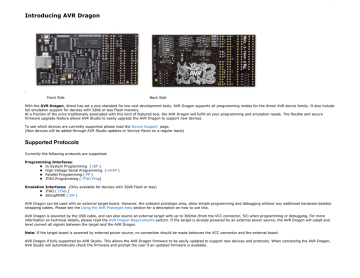
Have a read of the bug report for the details. The IDE does 2 avrdude commands instead of one and avrdude resets the USB when it exits. Its an interaction with USB enumeration and how the IDE uses ide. I'd use shorter if I could find a shorter one. I've run it directly off my desktop and my dell d620 laptop and an acer netbook,īut I never use the dragon to power the target circuit and I've not done any I haven't had any problems with USB power. How come lots of people aren't doing this?

#ATMEL DRAGON CODE#
What are the 6 lines of code needed to get avrdude able to work under the Arduino IDE with the Dragon? It's just for SPI programming mode, I'd guess, or can it be configured by avrdude options to do HV programming as well?Īnyway, thanks for your help. Once I get this set-up, I can see some real time-saving here. I'm looking forward to debugging some code on this set-up with peripherals attached to the Uno. Now, it has a new career! Actually, now that I think of it, I may have another go trying to resuscitate that 8u2 with the Dragon.) (It was a bit of a cripple anyway, with a no-op 8u2, so it wasn't communicating on the USB in an case.

I've got a specially prepared one that has had its "reset-en" trace cut today, just for the occasion. I might experiment a bit more with Atmel Studio, just to get a bit more familiar with it, and then I will look at getting it debugging on an Uno. Picky, picky, picky.īut once I got it working, it was all sweetness and light. So even a less than first-rate USB cable can make a difference with these guys. I was just about thinking of sending it back as a dud. Then I replaced my USB cable between the Dragon and hub with a shorter, better quality one. The laptop didn't recognise a device had been plugged in. First I tried just plugged into the laptop via a USB cable. I did find that the Dragon is indeed finicky about its power supply. ]:Dīwahahhahhha! Mere mortals, tremble and fear! Success! With my new god-like powers, I can set and reset lockbits, SPI_EN, or any other damn thing I feel like. The Dragon arrived today, and to get things started, I installed Atmel Studio (Windows only, of course) and soldered up some headers and a 28-pin socket to do some HV programming. That looks great! There's lots of fun to be had here, I think. The more recent dragons, (the ones with mounting holes, which have been shippingįor quite some time now) aren't as sensitive as the original ones. Here is some other information about dragon robustness: The draw back to my case is that you really can't do HV programming with it as it With a 10 pin and 6 pin header coming out the flat panel and the USB going into the curved side. On the case, if I were to do it again, I'd flip the board around and create a daughter board To support passing the byte counts around so I gave up. I looked at changing/fixing it but the issue was the needed byte count was not available way downĭeep in code and to fix it had massive ripple effects and required changing many functions They cause the memory dump to be really slow. Since it only uses 1 byte a time from the data fetched. So it ends up reading the data many more times than is necessary Its been a while since I looked at and I can't remember if was both flash and eeprom or justĮeprom, it but I think they ended up fetching a large block like 256 bytesĪnd then only use 1 byte of it. The way they fetch data on the dragon when you do a flash or eeprom dump is really dumb. Something else about interactive mode on the dragon.

avrdude tries to be smart when dealing with the fuses I can't remember on the fuse settings, but it may have more to do with avrdude


 0 kommentar(er)
0 kommentar(er)
